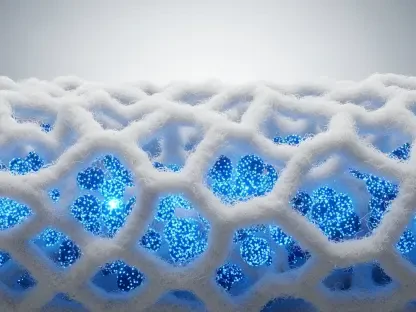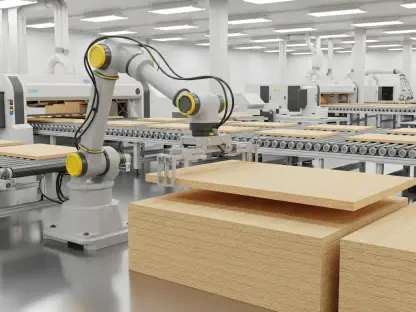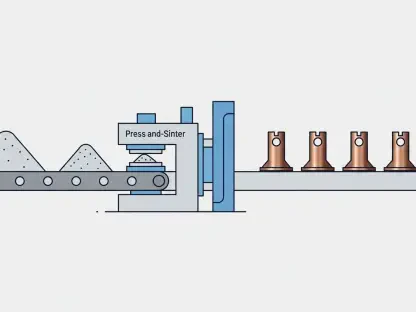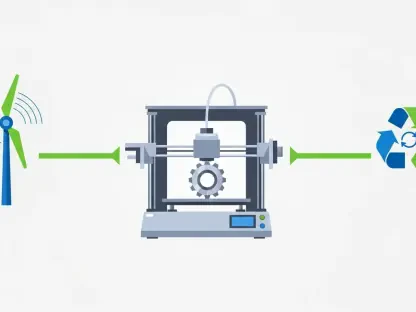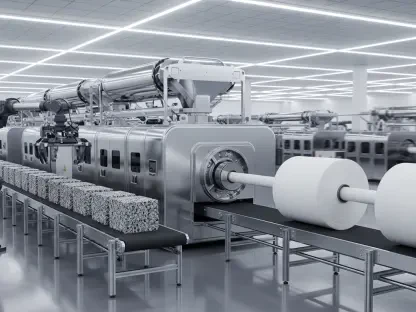In a landmark advancement that could redefine the future of materials science, researchers at the Massachusetts Institute of Technology (MIT) have uncovered a surprising truth about metallic alloys: delicate atomic arrangements, long thought to be obliterated by industrial processes, actually persist under the harshest manufacturing conditions. This discovery, detailed in a recently published study, challenges decades-old assumptions in metallurgy by demonstrating that chemical short-range order (SRO)—subtle, non-random patterns of atoms within a metal’s structure—survives intense mechanical stress and heat treatment. Far from being mere scientific curiosity, this finding holds profound implications for industries reliant on high-performance metals, from aerospace to nuclear energy. It suggests that the very processes used to shape alloys leave an indelible mark on their atomic makeup, influencing properties like strength and durability in ways previously unimagined. This breakthrough paves the way for innovative approaches to material design.
Decoding the Resilience of Atomic Structures
The core of this groundbreaking research lies in the concept of chemical short-range order, a phenomenon where atoms in metallic alloys form localized, non-random configurations within their crystal lattice. Traditional theories in materials science predicted that the chaos of industrial processes—such as rolling, forging, and heat treatment—would inevitably randomize these arrangements, leaving a uniform, disordered structure. However, the MIT team’s findings reveal a starkly different reality. Even under extreme temperatures and mechanical deformation, these atomic patterns remain remarkably stable, defying the disruptive forces at play. This persistence of SRO upends conventional wisdom, suggesting that the atomic architecture of alloys is far more resilient than once believed. It also raises critical questions about how these enduring structures influence a material’s behavior under stress, opening new avenues for exploration in metallurgy and beyond.
Another crucial insight from the study centers on the unexpected role of dislocations, which are line defects within a metal’s crystal structure. Historically viewed as agents of chaos that break atomic bonds and introduce disorder, dislocations are now shown to exhibit selective behavior that contributes to maintaining SRO. Rather than randomly disrupting the lattice, they preferentially sever weaker bonds, effectively reorganizing atoms into stable, non-random clusters. This process, observed under conditions mimicking real-world manufacturing, results in unique chemical motifs that are invisible in controlled laboratory settings. The discovery that dislocations can act as architects of atomic order rather than destroyers reshapes the understanding of how metals respond to processing. It highlights the dynamic interplay between defect structures and chemical arrangements, offering a fresh perspective on the fundamental mechanisms governing alloy properties.
Harnessing Technology to Reveal Atomic Secrets
The ability to detect and analyze these persistent atomic patterns owes much to the power of modern computational tools, which the MIT researchers employed with remarkable precision. By leveraging machine learning techniques alongside molecular dynamics simulations, the team tracked the movements of millions of atoms during processes that replicate industrial metalworking. These simulations, informed by quantum mechanical data, provided an unprecedented view of how chemical short-range order evolves over extended timescales. Unlike traditional experimental methods, which often struggle to capture atomic-scale phenomena in real time, this approach allowed for detailed observation of subtle structural changes under realistic conditions. The result is a deeper understanding of how manufacturing impacts atomic arrangements, marking a significant step forward in the study of materials at their most fundamental level.
Complementing these simulations, the integration of data-driven models and statistical analysis created a robust framework for validating the findings. The MIT team’s methodology not only confirmed the persistence of SRO but also established a repeatable process for studying similar phenomena in other materials. This computational prowess underscores a broader trend in materials science, where technology is increasingly used to tackle challenges that were once deemed infeasible. By simulating complex interactions at the atomic level, researchers can now predict how different processing conditions might affect a metal’s structure, offering insights that are both practical and transformative. This marriage of advanced technology with scientific inquiry sets a new benchmark for exploring the hidden intricacies of alloys, potentially influencing a wide range of industrial applications.
Shifting Perspectives on Metal Processing
Contrary to long-held beliefs, metal processing is emerging as a dynamic force that imprints lasting chemical structures rather than erasing them. The MIT study reveals that manufacturing processes like forging and heat treatment do not merely shape a metal’s form but also embed unique atomic signatures that influence its performance. The persistence of nonequilibrium SRO during these processes suggests that alloys retain a kind of atomic memory, shaped by the stresses they endure. This shift in perspective moves away from viewing processing as a purely destructive act and toward recognizing it as a creative force that can be harnessed. Such a viewpoint aligns with broader scientific principles about systems far from equilibrium, where complex order can emerge and persist despite external disruptions, offering a novel lens through which to understand material behavior.
This research also draws intriguing parallels between metallic alloys and biological systems, where nonequilibrium states often sustain organized structures through continuous energy exchange. In metals, the interaction between dislocations and atomic arrangements mirrors the adaptability seen in living organisms, positioning alloys as dynamic, responsive materials rather than static constructs. This conceptual bridge between materials science and biology enriches the discourse around solid-state systems, suggesting that metals under stress may exhibit behaviors akin to adaptive systems in nature. Such a connection encourages interdisciplinary exploration, inviting scientists from diverse fields to reconsider how fundamental principles of order and disorder apply to engineered materials. It’s a compelling reminder of the complexity hidden within seemingly simple substances.
Revolutionizing the Future of Alloy Engineering
The practical ramifications of the MIT findings are nothing short of revolutionary, promising to transform how alloys are designed and utilized across multiple industries. By understanding and manipulating chemical short-range order through tailored processing techniques, engineers can create materials with highly specific properties. For instance, lightweight yet ultra-strong alloys could redefine aerospace engineering, enabling the construction of more efficient aircraft and spacecraft. Similarly, materials with enhanced radiation resistance could prove invaluable in nuclear reactors, while optimized atomic arrangements might improve the efficiency of catalysts in chemical processes. This ability to fine-tune a material’s characteristics at the atomic level represents a significant leap forward, offering solutions to long-standing challenges in high-performance applications.
Looking to the horizon, the MIT team plans to expand their research by mapping how various fabrication methods and alloy compositions influence chemical order. These detailed correlations could serve as a blueprint for manufacturers, allowing them to predict and control atomic structures with unprecedented accuracy. Integrating atomic-scale design into everyday engineering practices holds the potential to streamline production while maximizing material performance. The transition from fundamental discovery to applied innovation appears poised for rapid progress, driven by the urgent demand for advanced metals in critical sectors. As this research unfolds, it may well catalyze a new era of material engineering, where the smallest building blocks of metals are harnessed to achieve extraordinary outcomes, reshaping industries for years to come.
Paving the Way for Material Innovation
Reflecting on the strides made by the MIT researchers, it’s clear that their work on chemical short-range order marks a pivotal moment in materials science. The revelation that atomic patterns endure the rigors of industrial processing, guided by the selective action of dislocations, dismantles outdated assumptions about alloy behavior. Supported by cutting-edge computational tools, the study provided a window into the atomic world that was once inaccessible, offering concrete evidence of SRO’s role in shaping material properties. This achievement not only deepens the understanding of metallic alloys but also establishes a foundation for future breakthroughs in how materials are studied and engineered.
Moving forward, the focus should shift to translating these insights into actionable strategies for material development. Industry leaders and researchers alike are encouraged to collaborate on creating processing protocols that deliberately enhance SRO, tailoring alloys for specific challenges like extreme environments or high-stress applications. Additionally, expanding the computational frameworks pioneered by the MIT team to other material classes, such as ceramics or composites, could unlock further innovations. By building on this discovery, the scientific community can drive a wave of advancements, ensuring that the hidden potential of atomic structures continues to be explored and applied in transformative ways.



